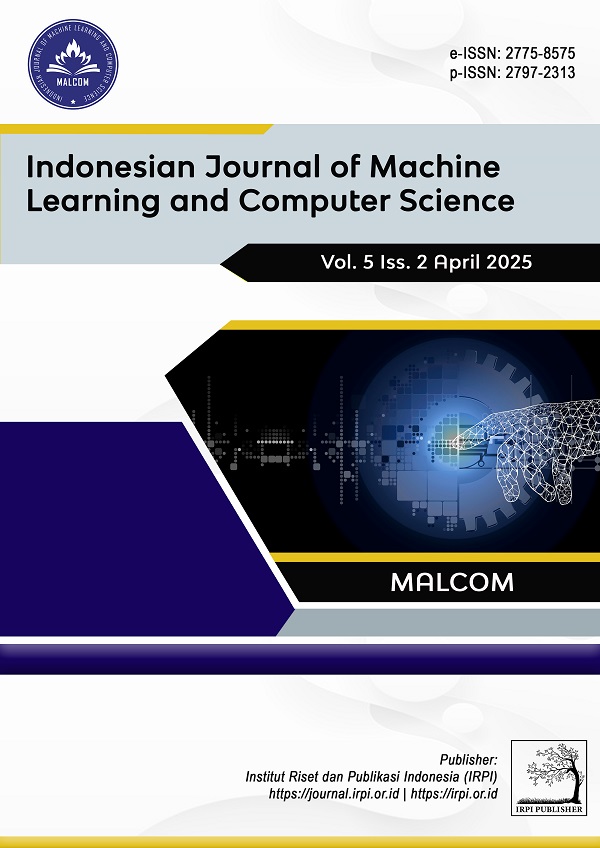Optimizing IT Governance in BTS.id: A COBIT 2019-Based Analysis of Design Factors
DOI:
https://doi.org/10.57152/malcom.v5i2.1997Keywords:
BTS.id, COBIT 2019, Design Factors, IT Governance, IT ManagementAbstract
Effective IT governance is critical for organizations to align technology with business objectives while ensuring risk management, compliance, and operational efficiency. As a technology-driven company, BTS.id faces challenges in managing IT risks, optimizing governance structures, and ensuring seamless alignment between IT initiatives and business strategy. This study analyzes IT governance implementation at BTS.id using the COBIT 2019 framework, focusing on assessing the organization's governance maturity level and identifying key design factors that influence IT governance effectiveness. The research employs document analysis, interviews, and surveys with key stakeholders to evaluate governance and management objectives, design factors, and capability levels. The findings indicate that while BTS.id has implemented IT governance practices, gaps remain in achieving an optimal governance structure. The highest priority areas include structured IT change management (BAI07), enterprise architecture (APO03), and project management (BAI11, BAI02), while risk management (APO12) and performance monitoring (MEA01) play a crucial supporting role. However, lower-priority governance objectives highlight areas for improvement, particularly in security management, vendor relationships, and compliance monitoring. The study underscores the importance of a structured approach to IT governance, emphasizing continuous performance monitoring, enhanced risk management, and strategic IT alignment.
Downloads
References
S. Vahdat, “The role of IT-based technologies on the management of human resources in the COVID-19 era,” Kybernetes, vol. 51, no. 6, pp. 2065–2088, Sep. 2021, doi: 10.1108/K-04-2021-0333.
A. I. Aljumah, M. T. Nuseir, and M. M. Alam, “Organizational performance and capabilities to analyze big data: do the ambidexterity and business value of big data analytics matter?,” Business Process Management Journal, vol. 27, no. 4, pp. 1088–1107, Jun. 2021, doi: 10.1108/BPMJ-07-2020-0335.
R. Martínez-Peláez et al., “Role of Digital Transformation for Achieving Sustainability: Mediated Role of Stakeholders, Key Capabilities, and Technology,” Sustainability, vol. 15, no. 14, Art. no. 14, Jan. 2023, doi: 10.3390/su151411221.
I. Kulkov, J. Kulkova, R. Rohrbeck, L. Menvielle, V. Kaartemo, and H. Makkonen, “Artificial intelligence - driven sustainable development: Examining organizational, technical, and processing approaches to achieving global goals,” Sustainable Development, vol. 32, no. 3, pp. 2253–2267, 2024, doi: 10.1002/sd.2773.
ISACA, Designing an Information and Technology Governance Solution. 2018.
ISACA, COBIT® 2019 Framework: Governance and Management Objectives. ISACA, 2018.
“COBIT | Control Objectives for Information Technologies,” ISACA. Accessed: Feb. 20, 2025. [Online]. Available: https://www.isaca.org/resources/cobit
“Software House Indonesia - Custom & Enterprise Software,” BTS.id. Accessed: Mar. 17, 2025. [Online]. Available: https://www.bts.id/
H. E. Adama, O. A. Popoola, C. D. Okeke, and A. E. Akinoso, “Theoretical Frameworks Supporting It And Business Strategy Alignment For Sustained Competitive Advantage,” International Journal of Management & Entrepreneurship Research, vol. 6, no. 4, Art. no. 4, Apr. 2024, doi: 10.51594/ijmer.v6i4.1058.
C.-I. Sepúlveda-Rivillas, J. Alegre, and V. Oltra, “Impact of knowledge-based organizational support on organizational performance through project management,” Journal of Knowledge Management, vol. 26, no. 4, pp. 993–1013, Jul. 2021, doi: 10.1108/JKM-12-2020-0887.
A. N. Wassan, M. S. Memon, S. I. Mari, and M. A. Kalwar, “Impact of Total Quality Management (TQM) practices on Sustainability and Organisational Performance,” Journal of Applied Research in Technology & Engineering, vol. 3, no. 2, Art. no. 2, Jul. 2022, doi: 10.4995/jarte.2022.17408.
G. M. W. Tangka and E. Lompoliu, “Information Technology Governance Using the COBIT 2019 Framework at PT. Pelindo TPK Bitung,” CogITo Smart Journal, vol. 9, no. 2, Art. no. 2, Dec. 2023, doi: 10.31154/cogito.v9i2.577.355-367.
G. M. W. Tangka and E. Lompoliu, “Enchancing IT Governance at BPS Manado: A COBIT 2019 Framework Implementation Study,” TeIKa, vol. 14, no. 1, Art. no. 1, Jun. 2024, doi: 10.36342/teika.v14i1.3325.
E. Lompoliu and G. M. W. Tangka, “Information Technology Governance Using the COBIT 2019 Framework at PT Bank Pembangunan Daerah Papua,” International Journal of Engineering, Science and Information Technology, vol. 4, no. 4, Art. no. 4, Nov. 2024, doi: 10.52088/ijesty.v4i4.609.
L. H. A. G. I. Belo and Y. T. Wiranti, “Perancangan Tata Kelola Teknologi Informasi Menggunakan COBIT 2019 Pada PT Telekomunikasi Indonesia Regional VI Kalimantan,” Jurnal Sist. Inf. Ilmu Komput. Prima, vol. 4, pp. 26-27, 2020.
S. De Haes, W. Van Grembergen, A. Joshi, and T. Huygh, “COBIT as a Framework for Enterprise Governance of IT,” in Enterprise Governance of Information Technology: Achieving Alignment and Value in Digital Organizations, S. De Haes, W. Van Grembergen, A. Joshi, and T. Huygh, Eds., Cham: Springer International Publishing, 2020, pp. 125–162. doi: 10.1007/978-3-030-25918-1_5.
S. F. Bayastura, S. Krisdina, and A. P. Widodo, “Analysis and Design of Information Technology Governance Using the Cobit 2019 Jiko,” vol. 4, no. 1. pp. 68-75, 2021. doi: 10.33387/jiko.
P. A. Adawiyah and L. H. Atrinawati, “Perancangan Tata Kelola Teknologi Informasi Menggunakan Framework Cobit 2019 Pada PT. XYZ,” JTSI, vol. 1, no. 2, pp. 1–9, Dec. 2020, doi: 10.33365/jtsi.v1i2.301.
P. Anastasia and L. Atrinawati, “Perancangan Tata Kelola Teknologi Informasi Menggunakan Framework Cobit 2019 Pada Hotel XYZ,” JSI: Jurnal Sistem Informasi (E-Journal), vol. 12, Oct. 2020, doi: 10.36706/jsi.v12i2.12329.
M. F. A. Faraby, “Audit Tata Kelola Teknologi Informasi Pada Dinas Komunikasi dan Informatika Kabupaten Agam Menggunakan Framework Cobit 2019,” bachelorThesis, Fakultas Sains dan Teknologi UIN Syarif Hidayatullah Jakarta, 2023. Accessed: Jul. 25, 2024. [Online]. Available: https://repository.uinjkt.ac.id/dspace/handle/123456789/71422
I. W. Budiana, K. Y. E. Aryanto, and I. M. G. Sunarya, “Penilaian Tata Kelola dan Manajemen Infrastruktur TI Bank BPD XYZ Menggunakan COBIT 2019: Assessment of IT Infrastructure Governance and Management Bank BPD XYZ Using the COBIT 2019,” MALCOM: Indonesian Journal of Machine Learning and Computer Science, vol. 4, no. 1, Art. no. 1, Jan. 2024, doi: 10.57152/malcom.v4i1.1043.
A. Safitri, I. Syafii, and K. Adi, “Measuring the Performance of Information System Governance using Framework COBIT 2019,” International Journal of Computer Applications, vol. 174, pp. 23–30, Apr. 2021, doi: 10.5120/ijca2021921253.
J. Souza Neto, F. Cavalcante, and R. Almeida, Lessons Learned in Designing a COBIT 2019 Framework for a Brazilian Financial Organization. 2019. doi: 10.13140/RG.2.2.36820.45440.
Downloads
Published
How to Cite
Issue
Section
License
Copyright (c) 2025 George Morris William Tangka, Erienika Lompoliu

This work is licensed under a Creative Commons Attribution-ShareAlike 4.0 International License.
Copyright © by Author; Published by Institut Riset dan Publikasi Indonesia (IRPI)
This Indonesian Journal of Machine Learning and Computer Science is licensed under a Creative Commons Attribution-ShareAlike 4.0 International License.




















